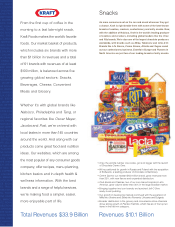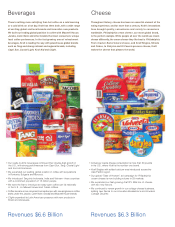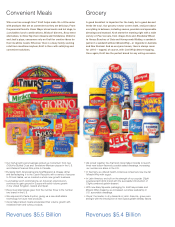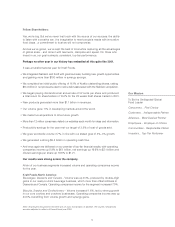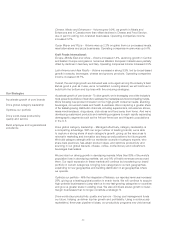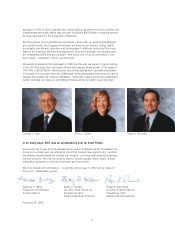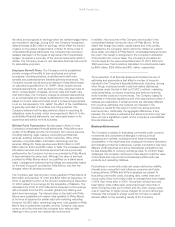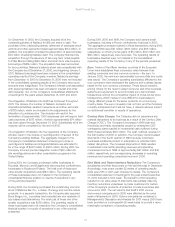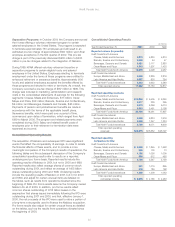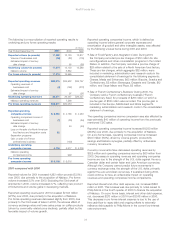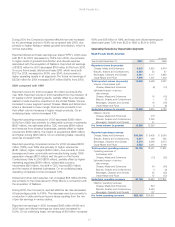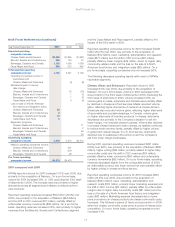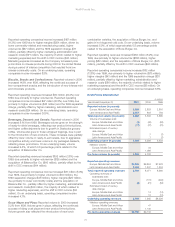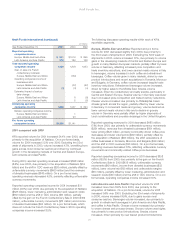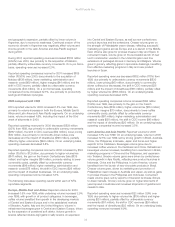Kraft 2001 Annual Report Download - page 29
Download and view the complete annual report
Please find page 29 of the 2001 Kraft annual report below. You can navigate through the pages in the report by either clicking on the pages listed below, or by using the keyword search tool below to find specific information within the annual report.
Kraft Foods Inc.
23
fair value are recognized in earnings when the related hedged items
are recorded in earnings. During 2001, the Company recognized
deferred losses of $15 million in earnings, which offset the impact
of gains on the related hedged items. In Note 16 of the notes to
consolidated financial statements, the Company has included a
detailed discussion of the types of exposures that it periodically
hedges, as well as a summary of the various instruments which it
utilizes. The Company does not use derivative financial instruments
for speculative purposes.
Employee Benefit Plans: The Company and its subsidiaries
provide a range of benefits to their employees and retired
employees, including pensions, postretirement health care
benefits and postemployment benefits (primarily severance). The
Company records annual amounts relating to these plans based
on calculations specified by U.S. GAAP, which include various
actuarial assumptions, such as discount rates, assumed rates of
return, compensation increases, turnover rates and health care
cost trend rates. The Company reviews its actuarial assumptions
on an annual basis and makes modifications to the assumptions
based on current rates and trends when it is deemed appropriate
to do so. As required by U.S. GAAP, the effect of the modifications
is generally recorded or amortized over future periods. The
Company believes that the assumptions utilized in recording its
obligations under its plans, which are presented in Note 14 to the
consolidated financial statements, are reasonable based on its
experience and advice from its actuaries.
Related Party Transactions: As discussed in Note 3 to the
Company’s consolidated financial statements, Philip Morris and
certain of its affiliates provide the Company with various services,
including planning, legal, treasury, accounting and financial
services, auditing, insurance, human resources, office of the
secretary, corporate affairs, information technology and tax
services. Billings for these services were $339 million in 2001,
$248 million in 2000 and $165 million in 1999. The increases reflect
information services and financial services that were previously
performed by the Company, but are now provided by Philip Morris
at approximately the same cost. Although the value of services
provided by Philip Morris cannot be quantified on a stand-alone
basis, management believes that the billings are reasonable based
on the level of support provided by Philip Morris, and that the
charges reflect all services provided.
The Company also has long-term notes payable to Philip Morris of
$5.0 billion at December 31, 2001 and $21.4 billion at December 31,
2000. A significant portion of the amount outstanding at December
31, 2000 related to borrowings for the acquisition of Nabisco. The
decrease from 2000 to 2001 reflects the repayment of borrowings
with proceeds from the IPO, a public global bond offering and
short-term borrowings. The interest rates on the debt with Philip
Morris were established at market rates available to Philip Morris
at the time of issuance for similar debt with matching maturities.
However, the $5.0 billion remaining long-term note payable to Philip
Morris has no prepayment penalty, and the Company may repay
some or all of the note with the proceeds from external debt
offerings in the current low interest rate environment.
In addition, the accounts of the Company are included in the
consolidated federal income tax return of Philip Morris. To the
extent that foreign tax credits, capital losses and other credits
generated by the Company, which cannot be utilized on a stand-
alone basis, are utilized in Philip Morris’ consolidated federal income
tax return, the benefit is recognized in the Company’s calculation
of its provision for income taxes. The Company’s provisions for
income taxes for the years ended December 31, 2001, 2000 and
1999 were lower than provisions calculated on a stand-alone basis
by $185 million, $139 million and $107 million, respectively.
The preparation of all financial statements includes the use of
estimates and assumptions that affect a number of amounts
included in the Company’s financial statements, including, among
other things, employee benefit costs and related disclosures,
inventories under the last-in-first-out (“LIFO”) method, marketing
costs (advertising, consumer incentives and trade promotions),
environmental costs and income taxes. The Company bases its
estimates on historical experience and other assumptions which it
believes are reasonable. If actual amounts are ultimately different
from previous estimates, the revisions are included in the
Company’s results for the period in which the actual amounts
become known. Historically, the aggregate differences, if any,
between the Company’s estimates and actual amounts in any year
have not had a significant impact on the Company’s consolidated
financial statements.
Business Environment
The Company is subject to fluctuating commodity costs, currency
movements and competitive challenges in various product
categories and markets, including a trend toward increasing
consolidation in the retail trade and consequent inventory reductions
and changing consumer preferences. Certain competitors may have
different profit objectives and some international competitors may
be less susceptible to currency exchange rates. To confront these
challenges, the Company continues to take steps to build the value
of its brands and improve its food business portfolio with new
products and marketing initiatives.
Fluctuations in commodity costs can cause retail price volatility,
intensify price competition and influence consumer and trade
buying patterns. KFNA’s and KFI’s businesses are subject to
fluctuating commodity costs, including dairy, coffee bean and
cocoa costs. Dairy commodity costs on average have been higher
in 2001 than those seen in 2000. Cocoa bean prices have also
been higher, while coffee bean prices have been lower than in
2000. During the latter part of 2000 and into 2001, energy costs
rose in response to higher prices charged for oil and natural gas.
However, this increase in energy costs did not have a material
adverse effect on the operating results of the Company.




